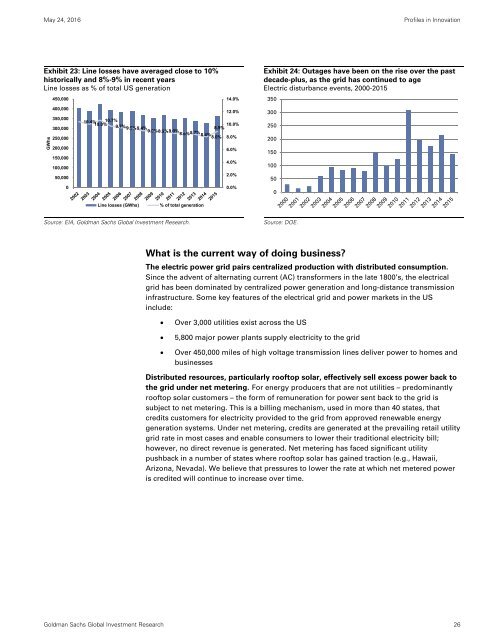PROFILES INNOVATION
Goldman-Sachs-report-Blockchain-Putting-Theory-into-Practice
Goldman-Sachs-report-Blockchain-Putting-Theory-into-Practice
Create successful ePaper yourself
Turn your PDF publications into a flip-book with our unique Google optimized e-Paper software.
May 24, 2016<br />
Profiles in Innovation<br />
Exhibit 23: Line losses have averaged close to 10%<br />
historically and 8%-9% in recent years<br />
Line losses as % of total US generation<br />
GWhs<br />
450,000<br />
400,000<br />
350,000<br />
300,000<br />
250,000<br />
200,000<br />
150,000<br />
100,000<br />
50,000<br />
0<br />
14.0%<br />
12.0%<br />
10.4% 10.7%<br />
10.0%<br />
9.7%<br />
10.0%<br />
9.5% 9.4% 8.9%<br />
9.0% 8.9% 9.0% 8.6% 8.7% 8.4% 8.0% 8.0%<br />
6.0%<br />
4.0%<br />
2.0%<br />
0.0%<br />
Exhibit 24: Outages have been on the rise over the past<br />
decade-plus, as the grid has continued to age<br />
Electric disturbance events, 2000-2015<br />
350<br />
300<br />
250<br />
200<br />
150<br />
100<br />
50<br />
0<br />
Line losses (GWhs)<br />
% of total generation<br />
Source: EIA, Goldman Sachs Global Investment Research.<br />
Source: DOE.<br />
What is the current way of doing business?<br />
The electric power grid pairs centralized production with distributed consumption.<br />
Since the advent of alternating current (AC) transformers in the late 1800’s, the electrical<br />
grid has been dominated by centralized power generation and long-distance transmission<br />
infrastructure. Some key features of the electrical grid and power markets in the US<br />
include:<br />
<br />
<br />
<br />
Over 3,000 utilities exist across the US<br />
5,800 major power plants supply electricity to the grid<br />
Over 450,000 miles of high voltage transmission lines deliver power to homes and<br />
businesses<br />
Distributed resources, particularly rooftop solar, effectively sell excess power back to<br />
the grid under net metering. For energy producers that are not utilities – predominantly<br />
rooftop solar customers – the form of remuneration for power sent back to the grid is<br />
subject to net metering. This is a billing mechanism, used in more than 40 states, that<br />
credits customers for electricity provided to the grid from approved renewable energy<br />
generation systems. Under net metering, credits are generated at the prevailing retail utility<br />
grid rate in most cases and enable consumers to lower their traditional electricity bill;<br />
however, no direct revenue is generated. Net metering has faced significant utility<br />
pushback in a number of states where rooftop solar has gained traction (e.g., Hawaii,<br />
Arizona, Nevada). We believe that pressures to lower the rate at which net metered power<br />
is credited will continue to increase over time.<br />
Goldman Sachs Global Investment Research 26


